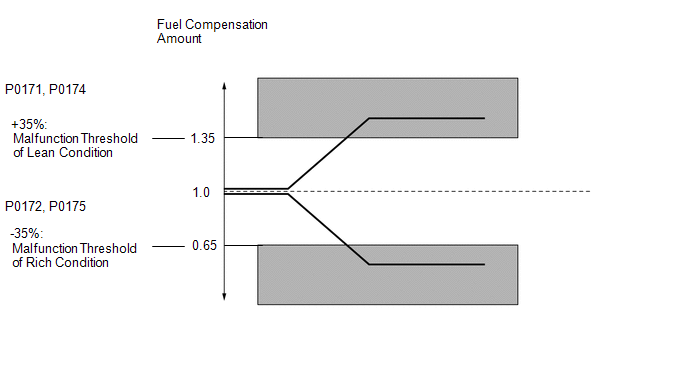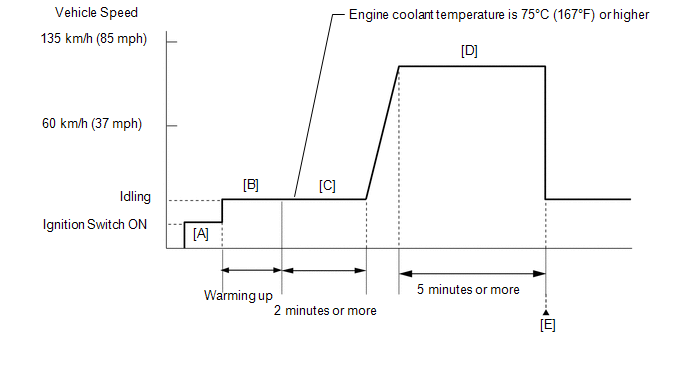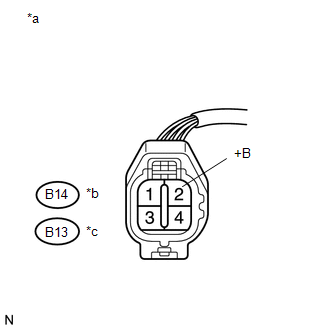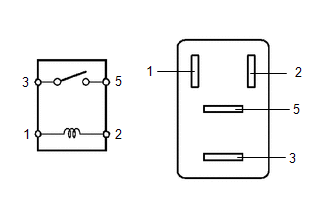- Intake system
- Fuel injector assembly blockage
- Mass air flow meter
- Engine coolant temperature sensor
- Fuel pressure
- Gas leak from exhaust system
- Open or short in air fuel ratio sensor (bank 1, 2 sensor 1) circuit
- Air fuel ratio sensor (bank 1, 2 sensor 1)
- A/F HTR relay
- PCV valve and hose
- PCV hose connections
- ECM
- Wire harness or connector
| Last Modified: 08-28-2024 | 6.11:8.1.0 | Doc ID: RM100000000VIB2 |
| Model Year Start: 2016 | Model: Sienna | Prod Date Range: [12/2015 - 08/2016] |
| Title: 2GR-FE (ENGINE CONTROL): SFI SYSTEM: P0171,P0172,P0174,P0175; System Too Lean (Bank 1); 2016 MY Sienna [12/2015 - 08/2016] | ||
|
DTC |
P0171 |
System Too Lean (Bank 1) |
|
DTC |
P0172 |
System Too Rich (Bank 1) |
|
DTC |
P0174 |
System Too Lean (Bank 2) |
|
DTC |
P0175 |
System Too Rich (Bank 2) |
DESCRIPTION
The fuel trim is related to the feedback compensation value, not to the basic injection time. The fuel trim consists of both the short-term and the long-term fuel trims.
The short-term fuel trim is fuel compensation that is used to constantly maintain the air fuel ratio at stoichiometric levels. The signal from the air fuel ratio sensor indicates whether the air fuel ratio is rich or lean compared to the stoichiometric ratio. This triggers a reduction in the fuel injection volume if the air fuel ratio is rich and an increase in the fuel injection volume if it is lean.
Factors such as individual engine differences, wear over time and changes in operating environment cause short-term fuel trim to vary from the central value. The long-term fuel trim, which controls overall fuel compensation, compensates for long-term deviations in the fuel trim from the central value caused by the short-term fuel trim compensation.
|
DTC No. |
DTC Detection Condition |
Trouble Area |
|---|---|---|
|
P0171 P0174 |
With warm engine and stable air fuel ratio feedback, fuel trim is considerably in error to lean side (2 trip detection logic) |
|
|
P0172 P0175 |
With warm engine and stable air fuel ratio feedback, fuel trim is considerably in error to rich side (2 trip detection logic) |
|
HINT:
- When DTC P0171 or P0174 is stored, the actual air fuel ratio is on the lean side. When DTC P0172 or P0175 is stored, the actual air fuel ratio is on the rich side.
- If the vehicle runs out of fuel, the air fuel ratio is lean and DTC P0171 or P0174 may be stored. The MIL is then illuminated.
- When the total of the short-term and long-term fuel trim values is within the malfunction threshold (and the engine coolant temperature is more than 75°C [167°F]), the system is functioning normally.
MONITOR DESCRIPTION
Under closed-loop fuel control, fuel injection volumes that deviate from those estimated by the ECM cause changes in the long-term fuel trim compensation value. The long-term fuel trim is adjusted when there are persistent deviations in the short-term fuel trim values. Deviations from the ECM's estimated fuel injection volumes also affect the average fuel trim learning value, which is a combination of the average short-term fuel trim (fuel feedback compensation value) and the average long-term fuel trim (learning value of the air fuel ratio). If the average fuel trim learning value exceeds the malfunction thresholds, the ECM interprets this a fault in the fuel system and stores a DTC.
Example:
The average fuel trim learning value is +35% or more, or -35% or less, the ECM interprets this as a fuel system malfunction.

MONITOR STRATEGY
|
Related DTCs |
P0171: Fuel trim Lean (bank 1) P0172: Fuel trim Rich (bank 1) P0174: Fuel trim Lean (bank 2) P0175: Fuel trim Rich (bank 2) |
|
Required Sensors/Components (Main) |
Fuel system |
|
Required Sensors/Components (Related) |
Air fuel ratio sensor Mass air flow meter Crankshaft position sensor |
|
Frequency of Operation |
Continuous |
|
Duration |
Less than 10 seconds |
|
MIL Operation |
2 driving cycles |
|
Sequence of Operation |
None |
TYPICAL ENABLING CONDITIONS
Fuel-trim
|
Monitor runs whenever following DTCs not stored |
P0010, P0020 (Camshaft timing oil control valve bank 1, 2) P0011, P0021 (VVT system bank 1, 2 - advance) P0012, P0022 (VVT System bank 1, 2 - retard) P0013, P0023 (Exhaust oil control valve bank 1, 2) P0014, P0024 (Exhaust VVT system bank 1, 2 - advance) P0015, P0025 (Exhaust VVT system bank 1, 2 - retard) P0016, P0018 (VVT system - misalignment) P0017, P0019 (Exhaust VVT system bank 1, 2 - misalignment) P0031, P0032, P0051, P0052, P101D, P103D (Air fuel ratio sensor heater) P0102, P0103 (Mass air flow meter) P0115, P0117, P0118 (Engine coolant temperature sensor) P0120, P0121, P0122, P0123, P0220, P0222, P0223, P2135 (Throttle position sensor) P0125 (Insufficient coolant temperature for closed loop fuel control) P0335 (Crankshaft position sensor) P0340, P0342, P0343, P0345, P0347, P0348 (VVT sensor) P0351, P0352, P0353, P0354, P0355, P0356 (Igniter) P0365, P0367, P0368, P0390, P0392, P0393 (Exhaust VVT sensor) P0500 (Vehicle speed sensor) P219A, P219B, P219C, P219D, P219E, P219F, P21A0, P21A1 (Air fuel ratio imbalance) |
|
Fuel system status |
Closed loop |
|
Battery voltage |
11 V or higher |
|
Either of following conditions 1 or 2 set |
- |
|
1. Engine speed |
Less than 1000 rpm |
|
2. Engine load |
15.625% or more |
|
Catalyst monitor |
Not executed |
TYPICAL MALFUNCTION THRESHOLDS
Fuel-trim
|
Purge-cut |
Executing |
|
Either of following conditions 1 or 2 met |
- |
|
1. Average between short-term fuel trim and long-term fuel trim |
35% or more (varies with engine coolant temperature) |
|
2. Average between short-term fuel trim and long-term fuel trim |
-35% or less (varies with engine coolant temperature) |
CONFIRMATION DRIVING PATTERN

- Connect the Techstream to the DLC3.
- Turn the ignition switch to ON and turn the Techstream on.
-
Clear DTCs (even if no DTCs are stored, perform the clear DTC operation) (See page
![2016 MY Sienna [12/2015 - 08/2016]; 2GR-FE (ENGINE CONTROL): SFI SYSTEM: DTC CHECK / CLEAR](/t3Portal/stylegraphics/info.gif) ).
).
- Turn the ignition switch off and wait for at least 30 seconds.
- Turn the ignition switch to ON and turn the Techstream on [A].
- Start the engine and warm it up until the engine coolant temperature is 75°C (167°F) or higher with all the accessories switched off [B].
- With the engine warmed up, idle the engine for 2 minutes or more [C].
-
Drive the vehicle at a speed between 60 and 135 km/h (37 and 85 mph) for 5 minutes or more [D].
CAUTION:
When performing the confirmation driving pattern, obey all speed limits and traffic laws.
- Enter the following menus: Powertrain / Engine / Trouble Codes [E].
-
Read pending DTCs.
HINT:
If a pending DTC is output, the system is malfunctioning.
-
If no pending DTC is output, perform a universal trip and check for permanent DTCs (See page
![2016 MY Sienna [12/2015 - 08/2016]; 2GR-FE (ENGINE CONTROL): SFI SYSTEM: DTC CHECK / CLEAR](/t3Portal/stylegraphics/info.gif) ).
).
HINT:
- If a permanent DTC is output, the system is malfunctioning.
- If no permanent DTC is output, the system is normal.
WIRING DIAGRAM
CAUTION / NOTICE / HINT
NOTICE:
Inspect the fuses for circuits related to this system before performing the following inspection procedure.
HINT:
- Sensor 1 refers to the sensor closest to the engine assembly.
- Sensor 2 refers to the sensor farthest away from the engine assembly.
-
Bank 1 refers to the bank that includes the No. 1 cylinder*.
*: The No. 1 cylinder is the cylinder which is farthest from the transaxle.
- Bank 2 refers to the bank that does not include the No. 1 cylinder.
- A low air fuel ratio sensor voltage could be caused by a rich air fuel mixture. Check for conditions that would cause the engine to run rich.
- A high air fuel ratio sensor voltage could be caused by a lean air fuel mixture. Check for conditions that would cause the engine to run lean.
- Read freeze frame data using the Techstream. The ECM records vehicle and driving condition information as freeze frame data the moment a DTC is stored. When troubleshooting, freeze frame data can help determine if the vehicle was moving or stationary, if the engine was warmed up or not, if the air fuel ratio was lean or rich, and other data from the time the malfunction occurred.
PROCEDURE
|
1. |
CHECK ANY OTHER DTCS OUTPUT (IN ADDITION TO DTC P0171, P0172, P0174 OR P0175) |
(a) Connect the Techstream to the DLC3.
(b) Turn the ignition switch to ON.
(c) Turn the Techstream on.
(d) Enter the following menus: Powertrain / Engine / Trouble Codes.
(e) Read DTCs.
Result
|
Result |
Proceed to |
|---|---|
|
DTC P0171, P0172, P0174 or P0175 is output |
A |
|
DTC P0171, P0172, P0174 or P0175 and other DTCs are output |
B |
HINT:
If any DTCs other than P0171, P0172, P0174 or P0175 are output, troubleshoot those DTCs first.
| B |

|
|
|
2. |
CHECK PCV HOSE CONNECTIONS |
(a) Check the PCV hose connections (See page
![2016 MY Sienna [12/2015 - 08/2016]; 2GR-FE EMISSION CONTROL: PCV VALVE: COMPONENTS](/t3Portal/stylegraphics/info.gif) ).
).
OK:
PCV valve and hose are connected correctly and are not damaged.
| NG |

|
REPAIR OR REPLACE PCV HOSE |
|
|
3. |
CHECK INTAKE SYSTEM |
(a) Check the intake system for vacuum leaks.
OK:
No leaks from intake system.
HINT:
| NG |

|
REPAIR OR REPLACE INTAKE SYSTEM |
|
|
4. |
PERFORM ACTIVE TEST USING TECHSTREAM (CONTROL THE INJECTION VOLUME FOR A/F SENSOR) |
(a) Connect the Techstream to the DLC3.
(b) Start the engine.
(c) Turn the Techstream on.
(d) Warm up the engine at an engine speed of 2500 rpm for approximately 90 seconds.
(e) Enter the following menus: Powertrain / Engine / Active Test / Control the Injection Volume for A/F Sensor.
(f) Perform the Control the Injection Volume for A/F Sensor operation with the engine in an idling condition (press the RIGHT or LEFT button to change the fuel injection volume).
(g) Monitor the voltage outputs of the air fuel ratio and heated oxygen sensors (AFS Voltage B1S1 and O2S B1S2 or AFS Voltage B2S1 and O2S B2S2) displayed on the Techstream.
HINT:
- Perform the Active Test operation with the engine idling (press the -12.5% or 12.5% button to change the fuel injection volume).
- Each sensor reacts in accordance with increases and decreases in the fuel injection volume.
- The air fuel ratio sensor has an output delay of a few seconds and the heated oxygen sensor has a maximum output delay of approximately 20 seconds.
- If the sensor output voltage does not change (almost no reaction) while performing the Active Test, the sensor may be malfunctioning.
Standard Voltage:
|
Techstream Display (Sensor) |
Injection Volume |
Status |
Voltage |
|---|---|---|---|
|
AFS Voltage B1S1 or AFS Voltage B2S1 (Air fuel ratio) |
12.5% |
Rich |
Less than 3.1 |
|
-12.5% |
Lean |
More than 3.4 |
|
|
O2S B1S2 or O2S B2S2 (Heated oxygen) |
12.5% |
Rich |
More than 0.55 |
|
-12.5% |
Lean |
Less than 0.4 |
Result
|
Status AFS Voltage B1S1 or AFS Voltage B2S1 |
Status O2S B1S2 or O2S B2S2 |
Air Fuel Ratio Condition and Air Fuel Ratio Sensor Condition |
Suspected Trouble Area |
Proceed to |
|---|---|---|---|---|
|
Lean/Rich |
Lean/Rich |
Normal |
- |
A |
|
Lean |
Lean |
Actual air fuel ratio lean |
|
A |
|
Rich |
Rich |
Actual air fuel ratio rich |
|
A |
|
Lean |
Lean/Rich |
Air fuel ratio sensor malfunction |
Air fuel ratio sensor |
B |
|
Rich |
Lean/Rich |
Air fuel ratio sensor malfunction |
Air fuel ratio sensor |
B |
Lean: During Control the Injection Volume for A/F Sensor, the air fuel ratio sensor output voltage (AFS Voltage B1S1 or AFS Voltage B2S1) is consistently more than 3.4 V, and the heated oxygen sensor output voltage (O2S B1S2 or O2S B2S2) is consistently less than 0.4 V.
Rich: During Control the Injection Volume for A/F Sensor, the AFS Voltage B1S1 or AFS Voltage B2S1 is consistently less than 3.1 V, and the O2S B1S2 or O2S B2S2 is consistently more than 0.55 V.
Lean/Rich: During Control the Injection Volume for A/F Sensor of the Active Test, the output voltage of the air fuel ratio sensor and heated oxygen sensor alternates correctly.
HINT:
Refer to "Data List / Active Test" [AFS Voltage B1S1, AFS Voltage B2S1, O2S B1S2 and O2S B2S2] (See page
![2016 MY Sienna [12/2015 - 08/2016]; 2GR-FE (ENGINE CONTROL): SFI SYSTEM: DATA LIST / ACTIVE TEST](/t3Portal/stylegraphics/info.gif) ).
).
| B |

|
|
|
5. |
READ VALUE USING TECHSTREAM (COOLANT TEMP) |
(a) Connect the Techstream to the DLC3.
(b) Turn the ignition switch to ON.
(c) Turn the Techstream on.
(d) Enter the following menus: Powertrain / Engine / Data List / Coolant Temp.
(e) Read the Coolant Temp twice, when the engine is both cold and warmed up.
Standard:
|
Techstream Display |
Condition |
Specified Condition |
|---|---|---|
|
Coolant Temp |
Cold engine |
Same as ambient air temperature |
|
Warm engine |
Between 75 and 100°C (167 and 212°F) |
HINT:
Perform "Inspection After Repair" after replacing the engine coolant temperature sensor (See page
![2016 MY Sienna [12/2015 - 08/2016]; 2GR-FE (ENGINE CONTROL): SFI SYSTEM: INITIALIZATION](/t3Portal/stylegraphics/info.gif) ).
).
| NG |

|
|
|
6. |
READ VALUE USING TECHSTREAM (MAF) |
(a) Connect the Techstream to the DLC3.
(b) Turn the ignition switch to ON.
(c) Turn the Techstream on.
(d) Enter the following menus: Powertrain / Engine / Data List / MAF, Coolant Temp and Engine Speed.
(e) Read MAF with the engine speed at 3000 rpm.
Standard:
|
Techstream Display |
Condition |
Specified Condition |
|---|---|---|
|
MAF |
Shift lever position: N (Neutral) A/C: Off Engine Speed: 3000 rpm |
Between 11 gm/sec. and 16 gm/sec |
| NG |

|
|
|
7. |
CHECK FUEL PRESSURE |
(a) Check the fuel pressure (See page
![2016 MY Sienna [12/2015 - 08/2016]; 2GR-FE FUEL: FUEL SYSTEM: ON-VEHICLE INSPECTION+](/t3Portal/stylegraphics/info.gif) ).
).
| NG |

|
REPAIR OR REPLACE FUEL SYSTEM |
|
|
8. |
CHECK FOR EXHAUST GAS LEAK |
(a) Check for exhaust gas leaks.
OK:
No exhaust gas leaks.
HINT:
Perform "Inspection After Repair" after replacing the exhaust system (See page
![2016 MY Sienna [12/2015 - 08/2016]; 2GR-FE (ENGINE CONTROL): SFI SYSTEM: INITIALIZATION](/t3Portal/stylegraphics/info.gif) ).
).
| NG |

|
REPAIR OR REPLACE EXHAUST GAS LEAK POINT |
|
|
9. |
CHECK FOR SPARKS AND IGNITION |
(a) Perform a spark test.
HINT:
-
Refer to the ignition system inspection procedure (See page
![2016 MY Sienna [12/2015 - 08/2016]; 2GR-FE (ENGINE CONTROL): IGNITION SYSTEM: ON-VEHICLE INSPECTION](/t3Portal/stylegraphics/info.gif) ).
).
- If the spark plugs or ignition system malfunctions, engine misfire may occur. The misfire count can be read using the Techstream. Enter the following menus: Powertrain / Engine / Data List / Cylinder #1 Misfire Count (to Cylinder #6 Misfire Count).
-
Perform "Inspection After Repair" after repairing or replacing the ignition system (See page
![2016 MY Sienna [12/2015 - 08/2016]; 2GR-FE (ENGINE CONTROL): SFI SYSTEM: INITIALIZATION](/t3Portal/stylegraphics/info.gif) ).
).
| NG |

|
REPAIR OR REPLACE IGNITION SYSTEM |
|
|
10. |
INSPECT FUEL INJECTOR ASSEMBLY (INJECTION AND VOLUME) |
(a) Check the injection and volume.
HINT:
-
Refer to the fuel injector assembly inspection procedure (See page
![2016 MY Sienna [12/2015 - 08/2016]; 2GR-FE FUEL: FUEL INJECTOR: INSPECTION+](/t3Portal/stylegraphics/info.gif) ).
).
- If the injectors malfunction, engine misfire may occur. The misfire count can be read using the Techstream. Enter the following menus: Powertrain / Engine / Data List / Cylinder #1 Misfire Count (to Cylinder #6 Misfire Count).
-
Perform "Inspection After Repair" after replacing the fuel injector assembly (See page
![2016 MY Sienna [12/2015 - 08/2016]; 2GR-FE (ENGINE CONTROL): SFI SYSTEM: INITIALIZATION](/t3Portal/stylegraphics/info.gif) ).
).
| OK |

|
| NG |

|
|
11. |
INSPECT AIR FUEL RATIO SENSOR (HEATER RESISTANCE) |
(a) Inspect the air fuel ratio sensor (See page
![2016 MY Sienna [12/2015 - 08/2016]; 2GR-FE (ENGINE CONTROL): AIR FUEL RATIO SENSOR: INSPECTION+](/t3Portal/stylegraphics/info.gif) ).
).
| NG |

|
|
|
12. |
CHECK TERMINAL VOLTAGE (POWER SOURCE OF AIR FUEL RATIO SENSOR) |

(a) Disconnect the air fuel ratio sensor connectors.
(b) Turn the ignition switch to ON.
(c) Measure the voltage according to the value(s) in the table below.
Standard Voltage:
|
Tester Connection |
Switch Condition |
Specified Condition |
|---|---|---|
|
B14-2 (+B) - Body ground |
Ignition switch ON |
11 to 14 V |
|
B13-2 (+B) - Body ground |
Ignition switch ON |
11 to 14 V |
Text in Illustration
|
*a |
Front view of wire harness connector (to Air Fuel Ratio Sensor) |
|
*b |
for Bank 1 |
|
*c |
for Bank 2 |
| NG |

|
|
|
13. |
CHECK HARNESS AND CONNECTOR (AIR FUEL RATIO SENSOR - ECM) |
(a) Disconnect the B13 and B14 air fuel ratio sensor connectors.
(b) Disconnect the B1 ECM connector.
(c) Measure the resistance according to the value(s) in the table below.
Standard Resistance:
|
Tester Connection |
Condition |
Specified Condition |
|---|---|---|
|
B14-1 (HA1A) - B1-22 (HA1A) |
Always |
Below 1 Ω |
|
B14-3 (A1A+) - B1-126 (A1A+) |
Always |
Below 1 Ω |
|
B14-4 (A1A-) - B1-125 (A1A-) |
Always |
Below 1 Ω |
|
B13-1 (HA2A) - B1-20 (HA2A) |
Always |
Below 1 Ω |
|
B13-3 (A2A+) - B1-103 (A2A+) |
Always |
Below 1 Ω |
|
B13-4 (A2A-) - B1-102 (A2A-) |
Always |
Below 1 Ω |
|
B14-1 (HA1A) or B1-22 (HA1A) - Body ground |
Always |
10 kΩ or higher |
|
B14-3 (A1A+) or B1-126 (A1A+) - Body ground |
Always |
10 kΩ or higher |
|
B14-4 (A1A-) or B1-125 (A1A-) - Body ground |
Always |
10 kΩ or higher |
|
B13-1 (HA2A) or B1-20 (HA2A) - Body ground |
Always |
10 kΩ or higher |
|
B13-3 (A2A+) or B1-103 (A2A+) - Body ground |
Always |
10 kΩ or higher |
|
B13-4 (A2A-) or B1-102 (A2A-) - Body ground |
Always |
10 kΩ or higher |
| NG |

|
REPAIR OR REPLACE HARNESS OR CONNECTOR |
|
|
14. |
REPLACE AIR FUEL RATIO SENSOR |
(a) Replace the air fuel ratio sensor (See page
![2016 MY Sienna [12/2015 - 08/2016]; 2GR-FE (ENGINE CONTROL): AIR FUEL RATIO SENSOR: REMOVAL](/t3Portal/stylegraphics/info.gif) ).
).
HINT:
Perform "Inspection After Repair" after replacing the air fuel ratio sensor (See page
![2016 MY Sienna [12/2015 - 08/2016]; 2GR-FE (ENGINE CONTROL): SFI SYSTEM: INITIALIZATION](/t3Portal/stylegraphics/info.gif) ).
).
|
|
15. |
CHECK WHETHER DTC OUTPUT RECURS (DTC P0171, P0172, P0174 OR P0175) |
(a) Connect the Techstream to the DLC3.
(b) Turn the ignition switch to ON.
(c) Turn the Techstream on.
(e) Turn the ignition switch off and wait for at least 30 seconds.
(f) Turn the ignition switch to ON.
(g) Turn the Techstream on.
(h) Start the engine and warm it up.
(i) Drive the vehicle in accordance with the driving pattern described in the Confirmation Driving Pattern.
(j) Enter the following menus: Powertrain / Engine / Trouble Codes.
(k) Read the pending DTCs.
Result
|
Result |
Proceed to |
|---|---|
|
DTC P0171, P0172, P0174 or P0175 is output |
A |
|
DTC is not output |
B |
| B |

|
END |
|
|
16. |
CHECK HARNESS AND CONNECTOR (MASS AIR FLOW METER CONNECTOR CONNECTION) |
(a) Check the connection and terminal contact pressure of connectors and wire harnesses between the mass air flow meter and ECM (See page
![2016 - 2020 MY Sienna [12/2015 - ]; INTRODUCTION: HOW TO TROUBLESHOOT ECU CONTROLLED SYSTEMS: ELECTRONIC CIRCUIT INSPECTION PROCEDURE](/t3Portal/stylegraphics/info.gif) ).
).
HINT:
Repair any problems.
|
|
17. |
CHECK WHETHER DTC OUTPUT RECURS (DTC P0171, P0172, P0174 OR P0175) |
(a) Connect the Techstream to the DLC3.
(b) Turn the ignition switch to ON.
(c) Turn the Techstream on.
(e) Turn the ignition switch off and wait for at least 30 seconds.
(f) Turn the ignition switch to ON.
(g) Turn the Techstream on.
(h) Start the engine and warm it up.
(i) Drive the vehicle in accordance with the driving pattern described in the Confirmation Driving Pattern.
(j) Enter the following menus: Powertrain / Engine / Trouble Codes.
(k) Read the pending DTCs.
Result
|
Result |
Proceed to |
|---|---|
|
DTC P0171, P0172, P0174 or P0175 is output |
A |
|
DTC is not output |
B |
| B |

|
END |
|
|
18. |
CHECK HARNESS AND CONNECTOR (MASS AIR FLOW METER - ECM) |
| NG |

|
REPAIR OR REPLACE HARNESS OR CONNECTOR |
|
|
19. |
REPLACE MASS AIR FLOW METER |
(a) Replace the mass air flow meter (See page
![2016 MY Sienna [12/2015 - 08/2016]; 2GR-FE (ENGINE CONTROL): MASS AIR FLOW METER: REMOVAL](/t3Portal/stylegraphics/info.gif) ).
).
HINT:
|
|
20. |
CONFIRM WHETHER MALFUNCTION HAS BEEN SUCCESSFULLY REPAIRED |
(a) Connect the Techstream to the DLC3.
(b) Turn the ignition switch to ON.
(c) Turn the Techstream on.
(e) Turn the ignition switch off and wait for at least 30 seconds.
(f) Turn the ignition switch to ON.
(g) Turn the Techstream on.
(h) Start the engine and warm it up.
(i) Drive the vehicle in accordance with the driving pattern described in the Confirmation Driving Pattern.
(j) Enter the following menus: Powertrain / Engine / Trouble Codes.
(k) Read the pending DTCs.
Result
|
Result |
Proceed to |
|---|---|
|
DTC is not output |
A |
|
DTC P0171, P0172, P0174 or P0175 is output |
B |
| A |

|
END |
| B |

|
|
21. |
CHECK HARNESS AND CONNECTOR (A/F HTR RELAY - AIR FUEL RATIO SENSOR) |
(a) Disconnect the B13 and B14 air fuel ratio sensor connectors.
(b) Remove the A/F HTR relay from the engine room relay block.
(c) Measure the resistance according to the value(s) in the table below.
Standard Resistance:
|
Tester Connection |
Condition |
Specified Condition |
|---|---|---|
|
B14-2 (+B) - 3 (A/F HTR relay holder) |
Always |
Below 1 Ω |
|
B13-2 (+B) - 3 (A/F HTR relay holder) |
Always |
Below 1 Ω |
|
B14-2 (+B) or 3 (A/F HTR relay holder) - Body ground |
Always |
10 kΩ or higher |
|
B13-2 (+B) or 3 (A/F HTR relay holder) - Body ground |
Always |
10 kΩ or higher |
| NG |

|
REPAIR OR REPLACE HARNESS OR CONNECTOR |
|
|
22. |
INSPECT A/F HTR RELAY |

(a) Remove the A/F HTR relay from the engine room relay block.
(b) Measure the resistance according to the value(s) in the table below.
Standard Resistance:
|
Tester Connection |
Condition |
Specified Condition |
|---|---|---|
|
3 - 5 |
Battery voltage not applied |
10 kΩ or higher |
|
Battery voltage applied to terminals 1 and 2 |
Below 1 Ω |
| OK |

|
| NG |

|
REPLACE A/F HTR RELAY |
|
|
|
